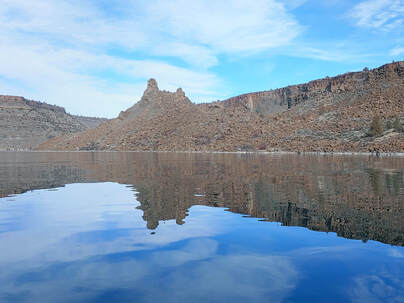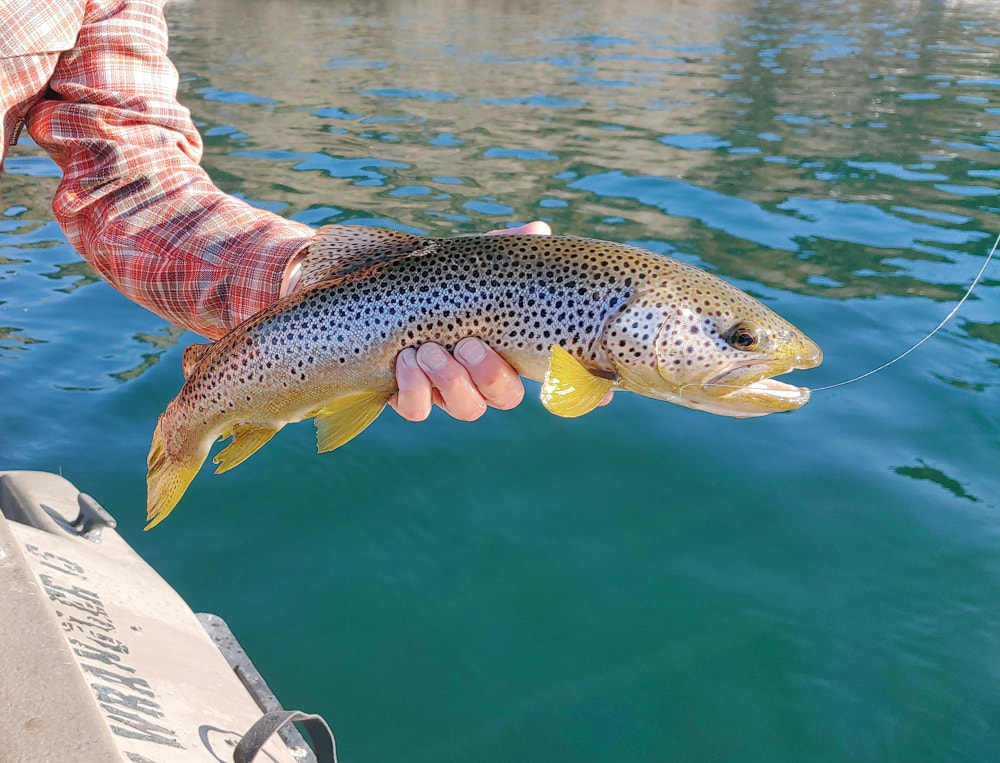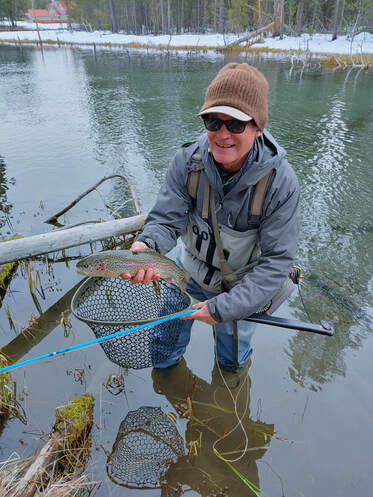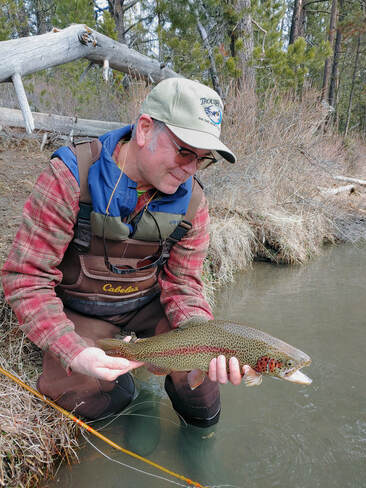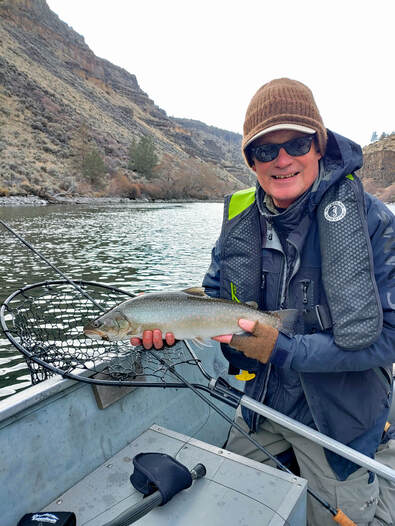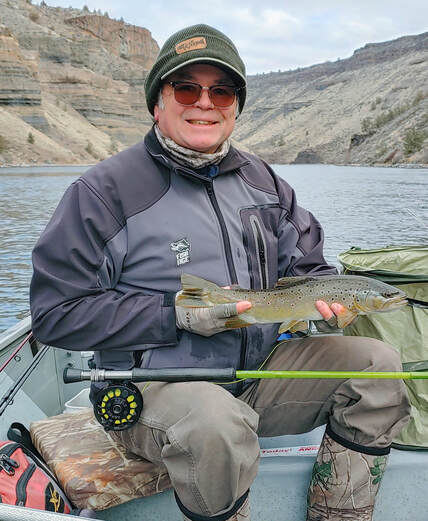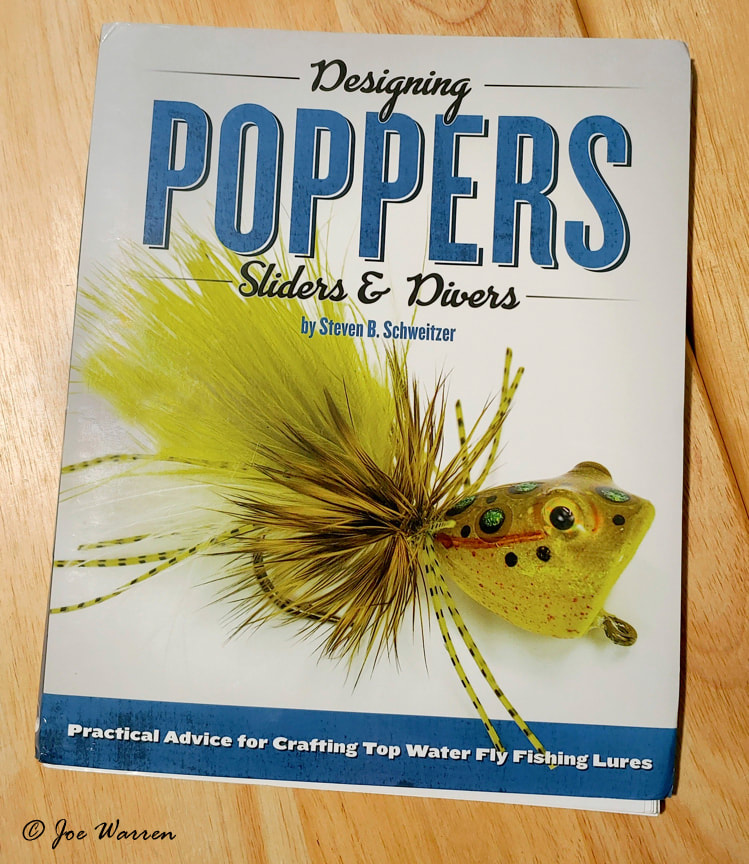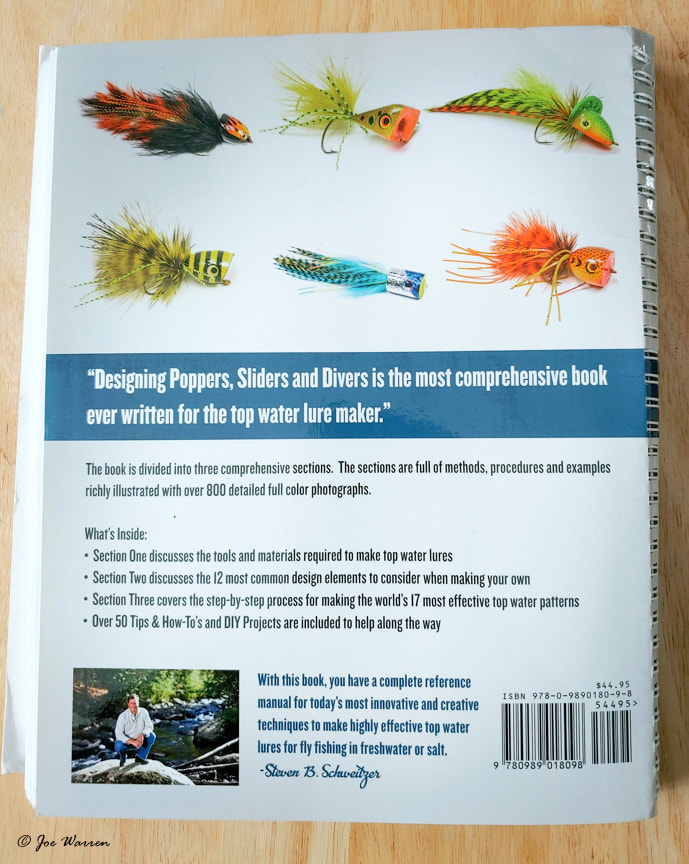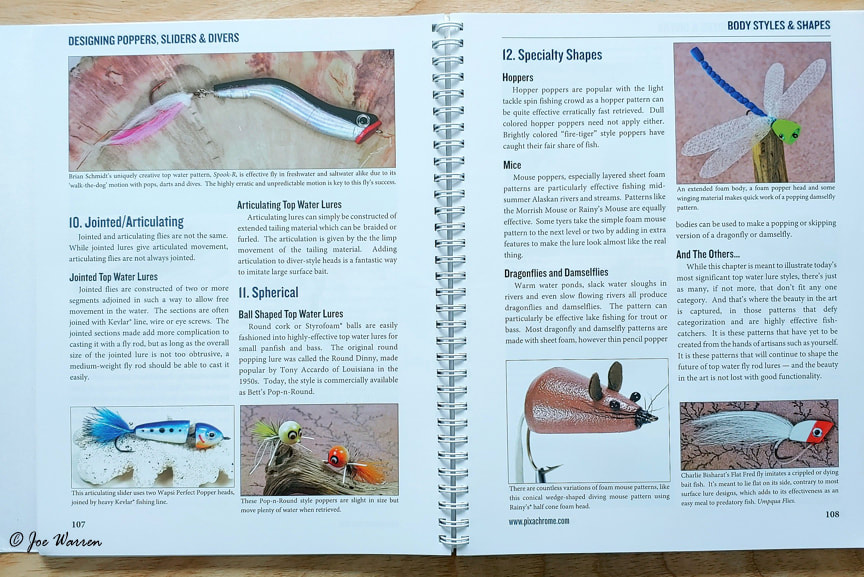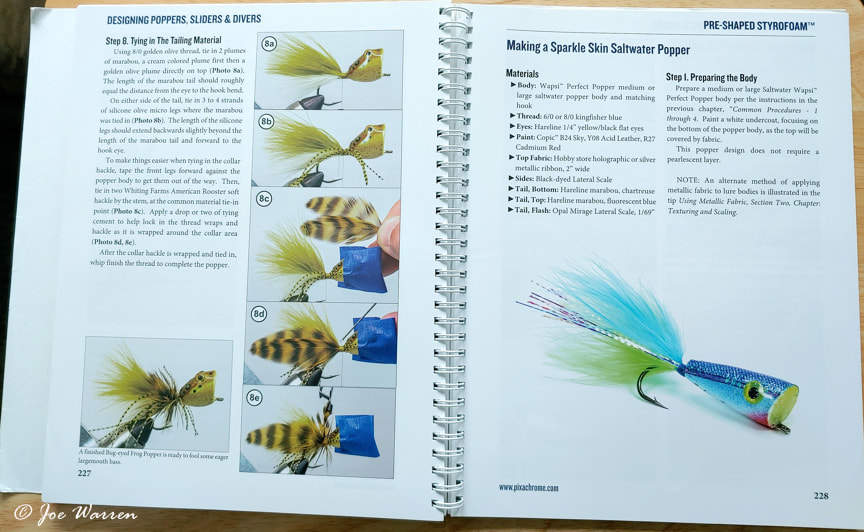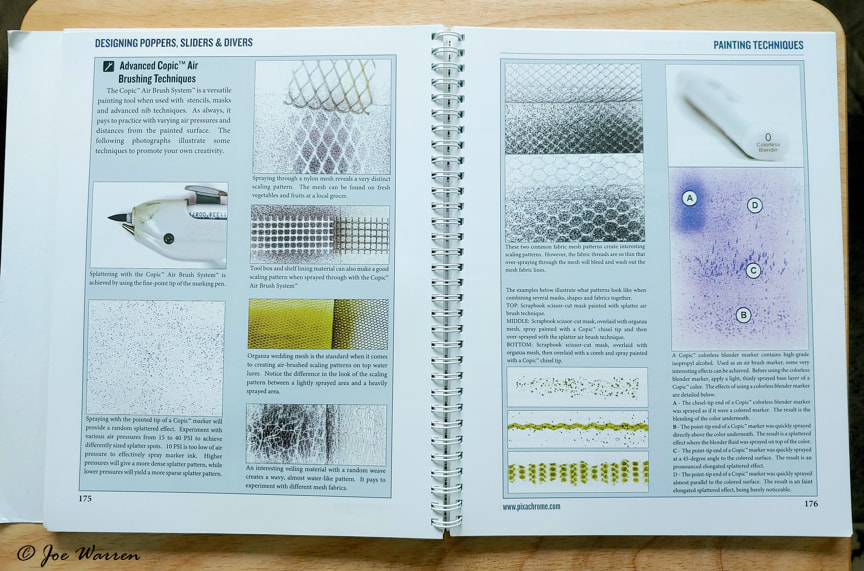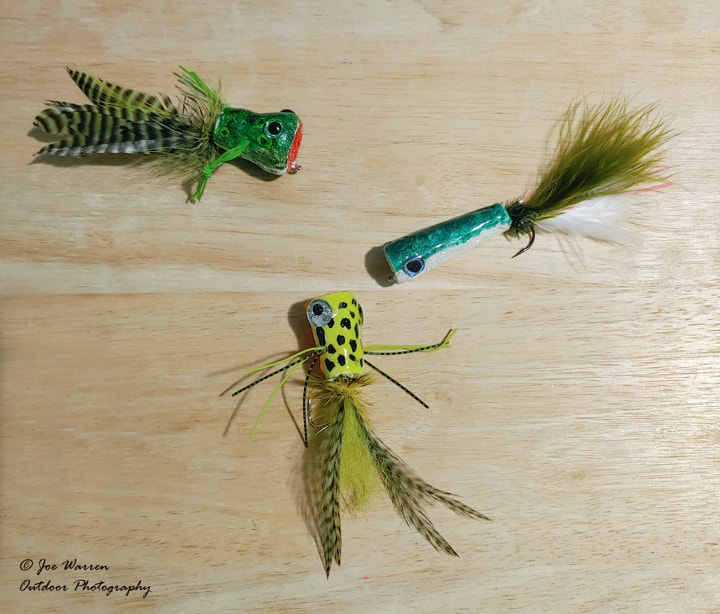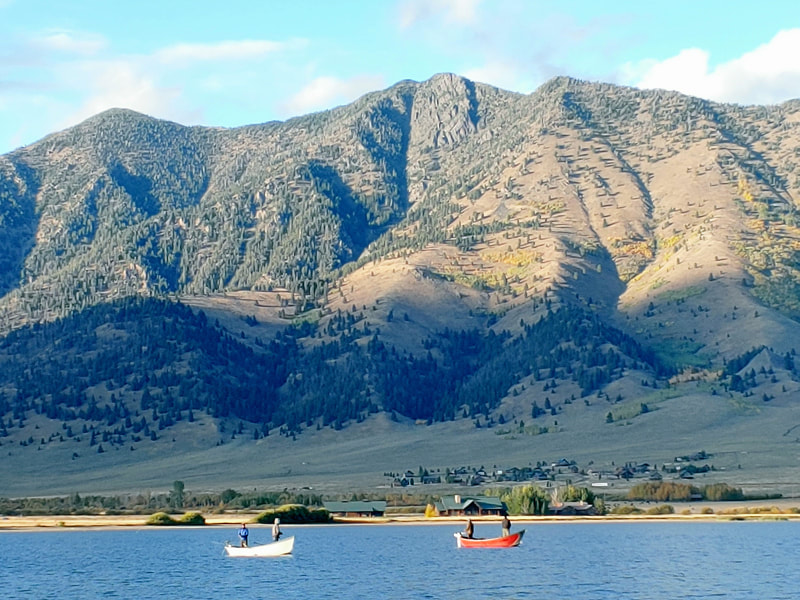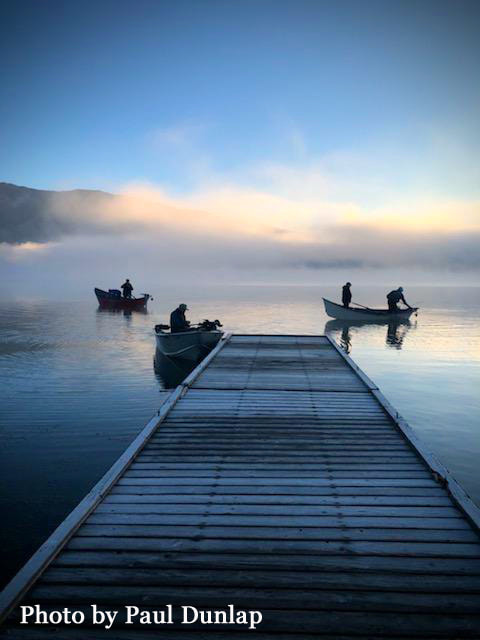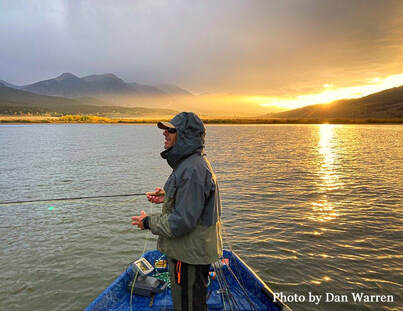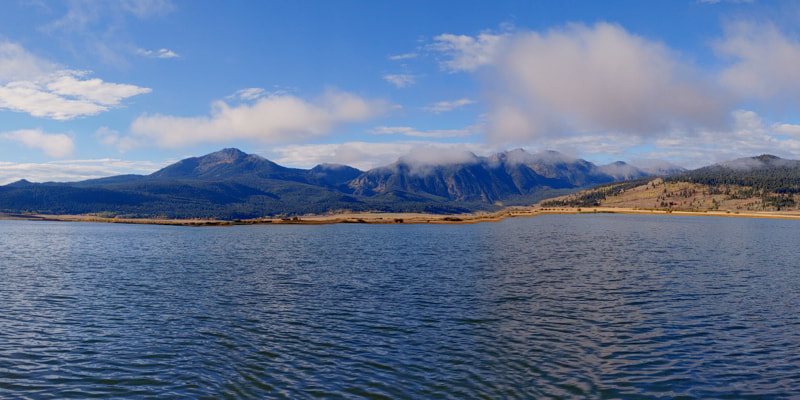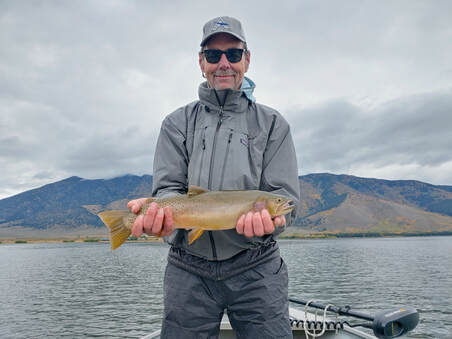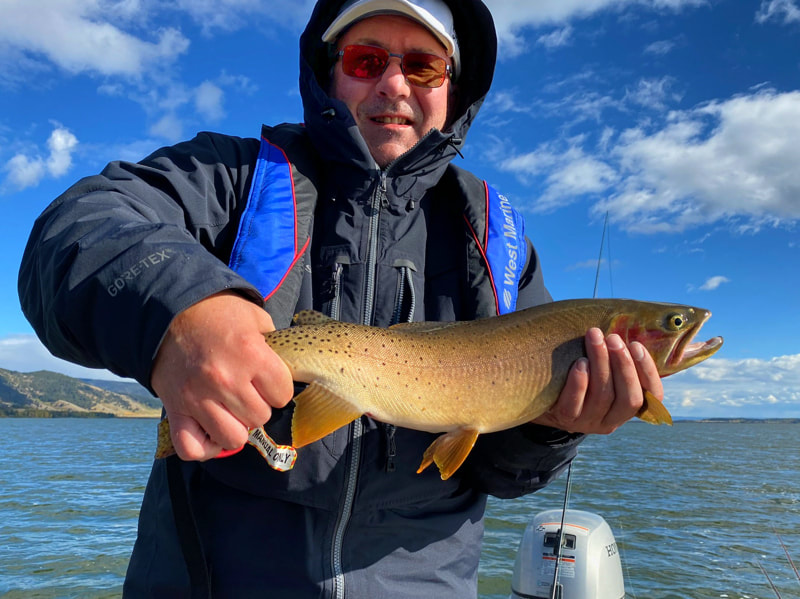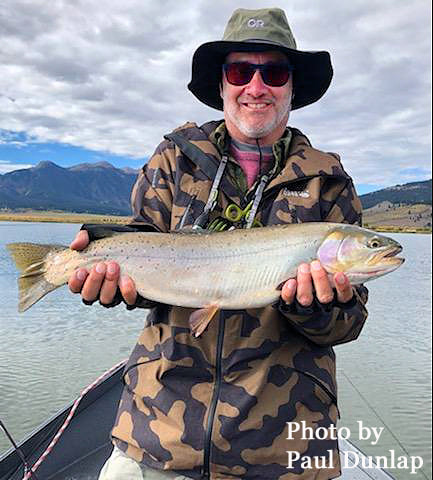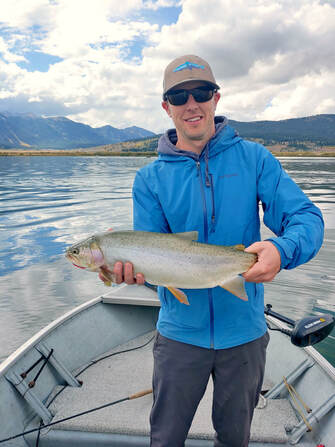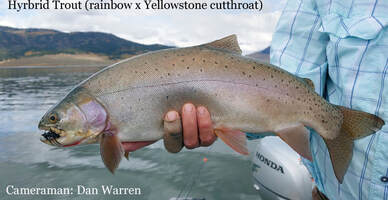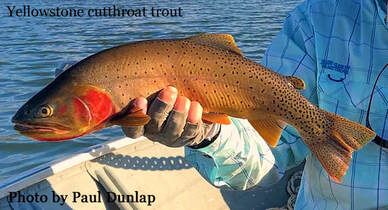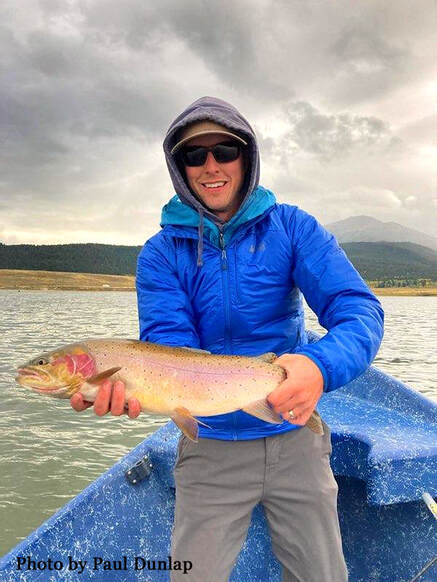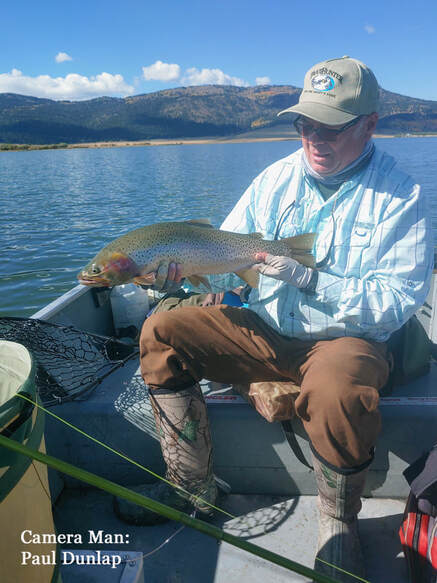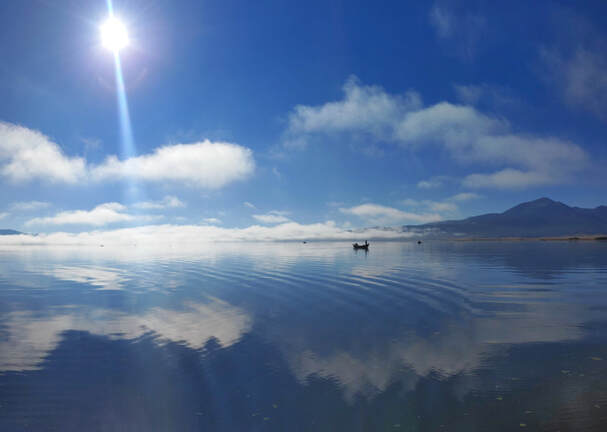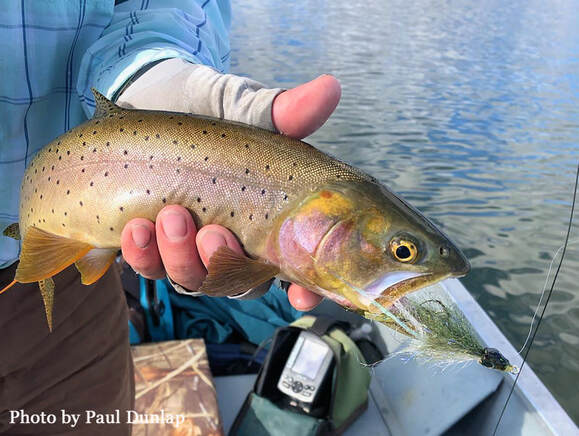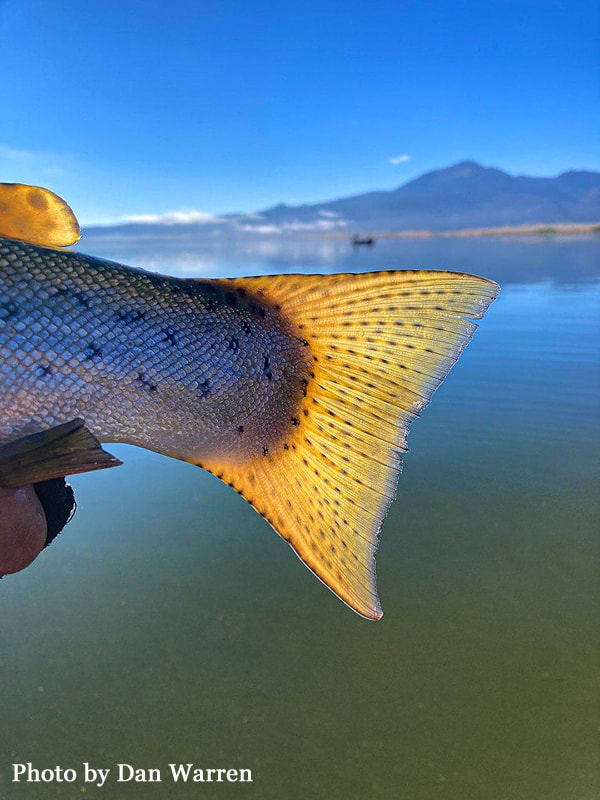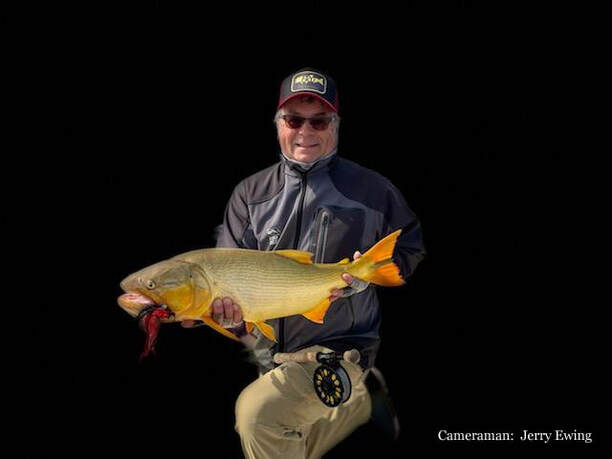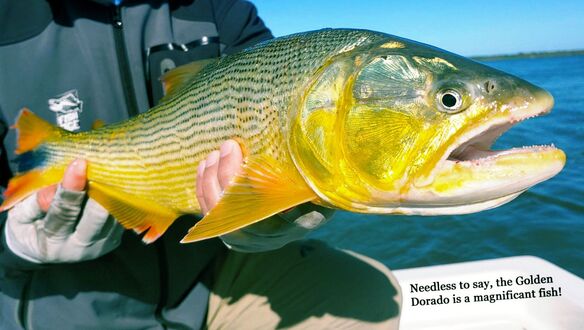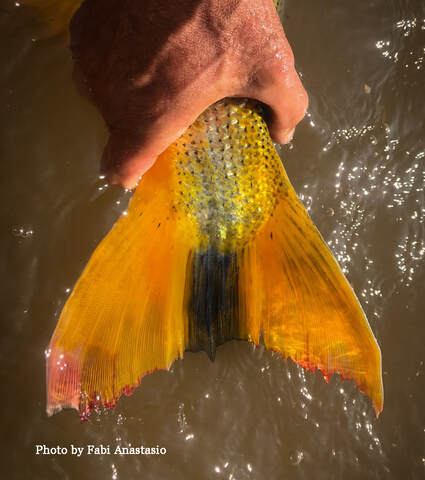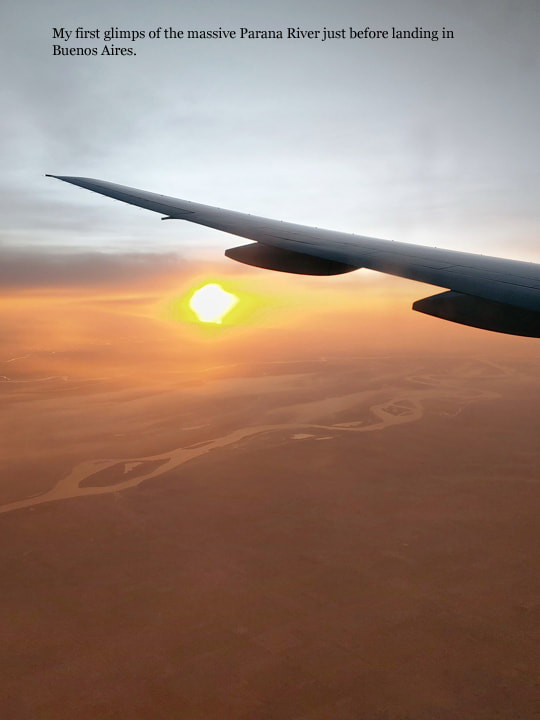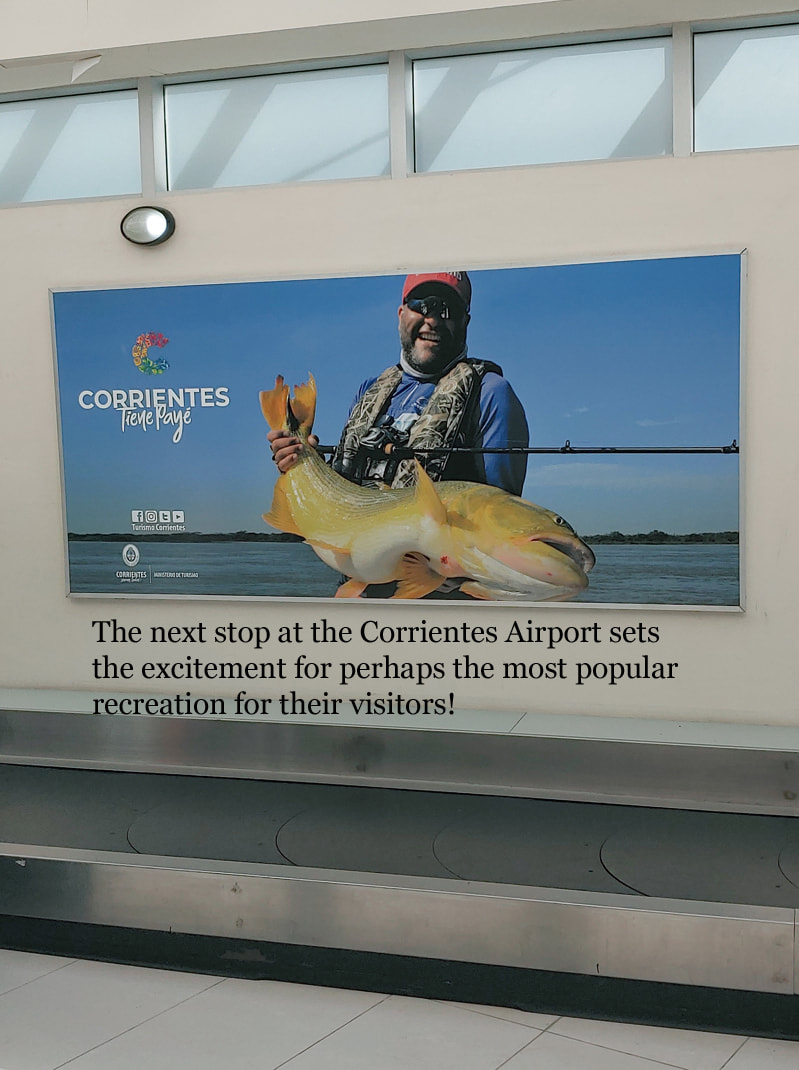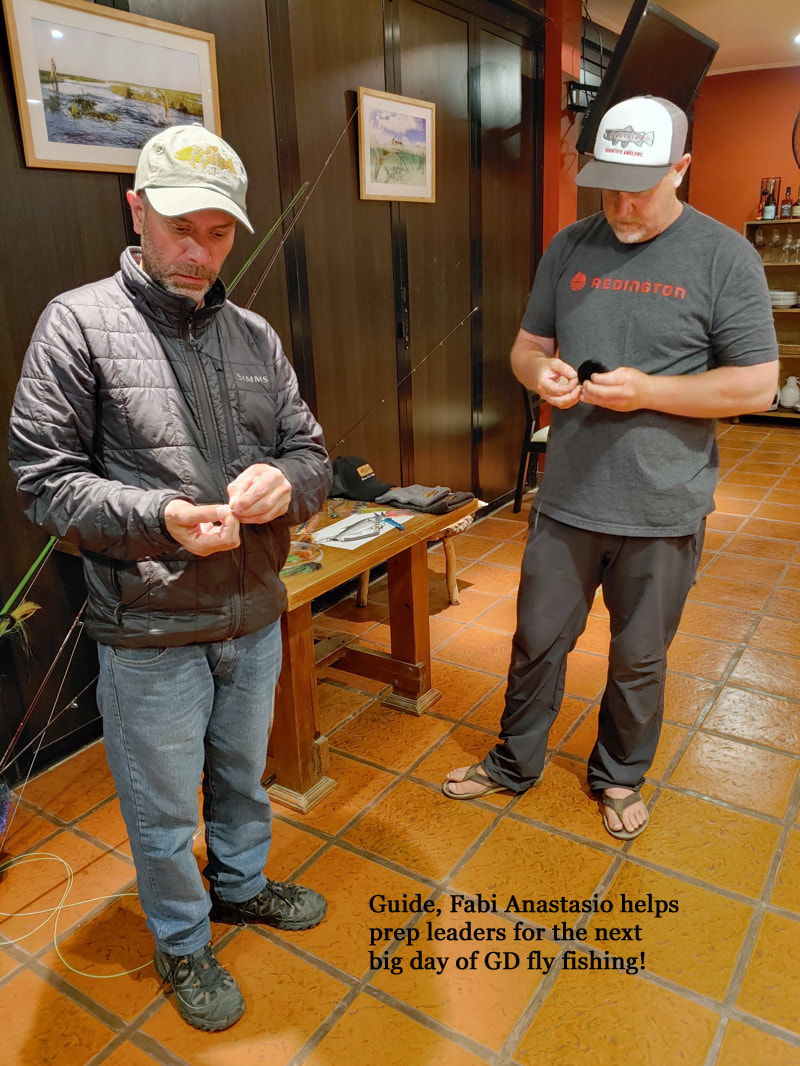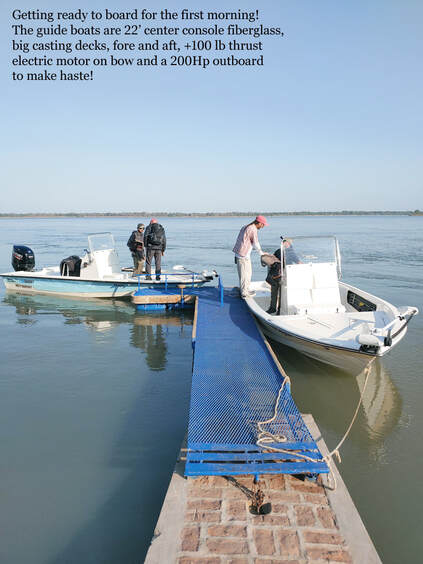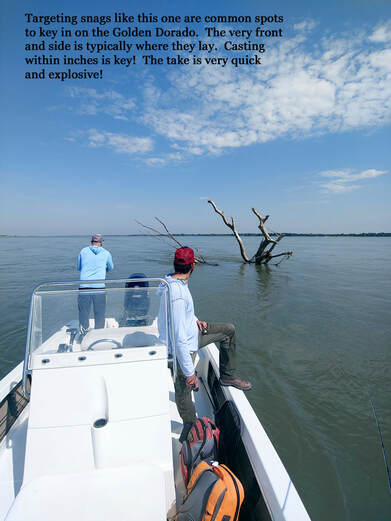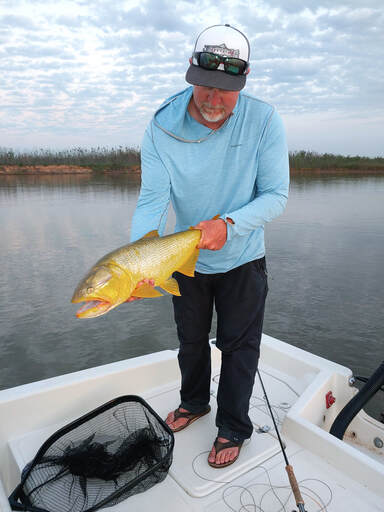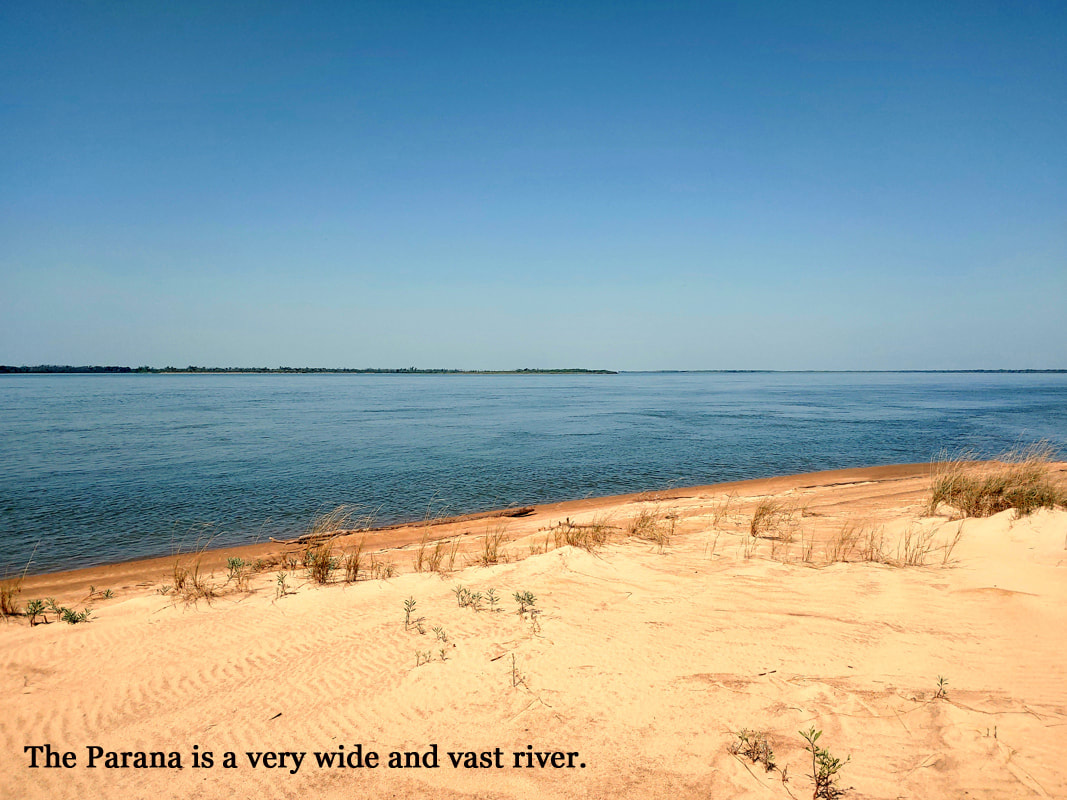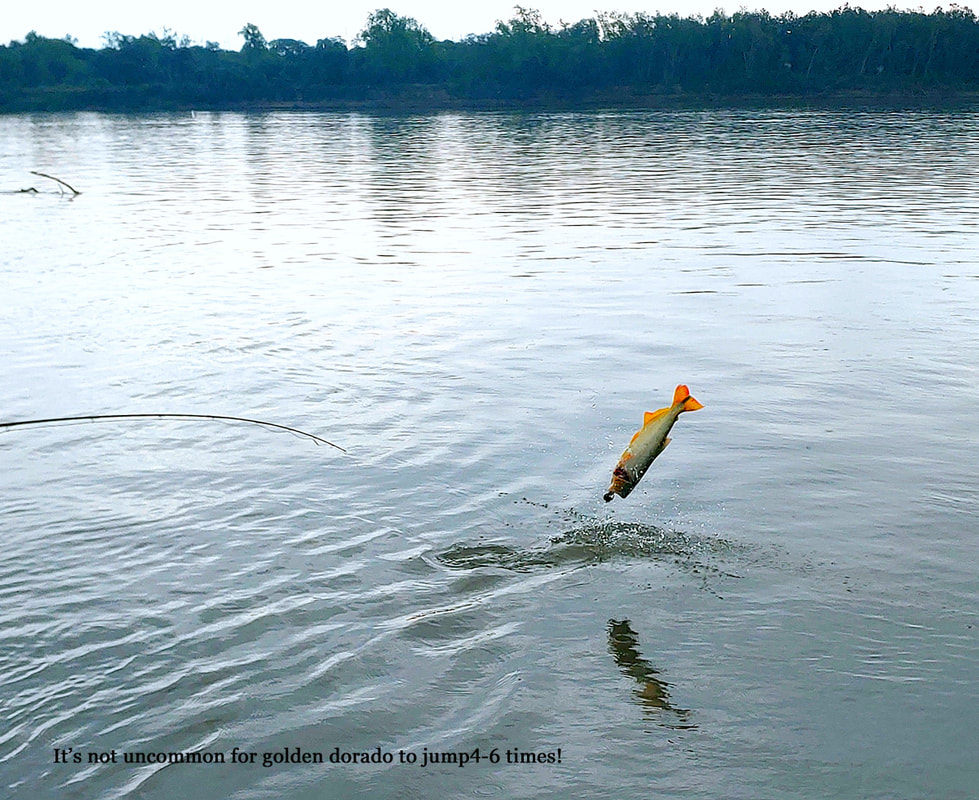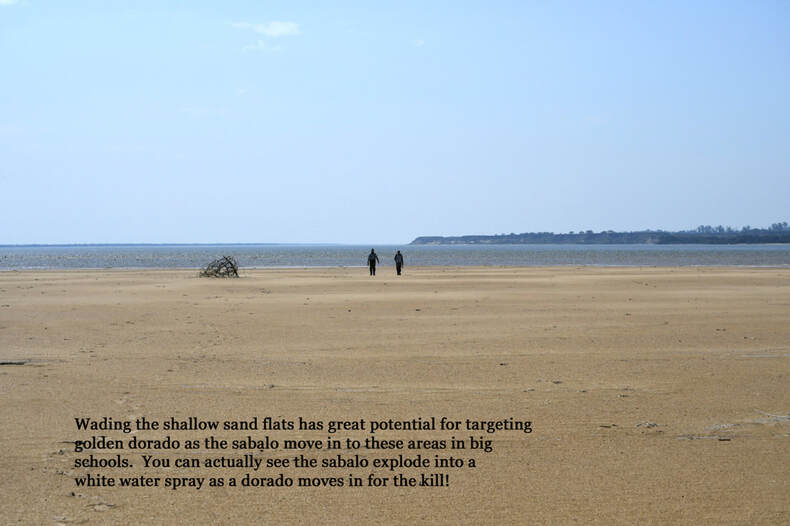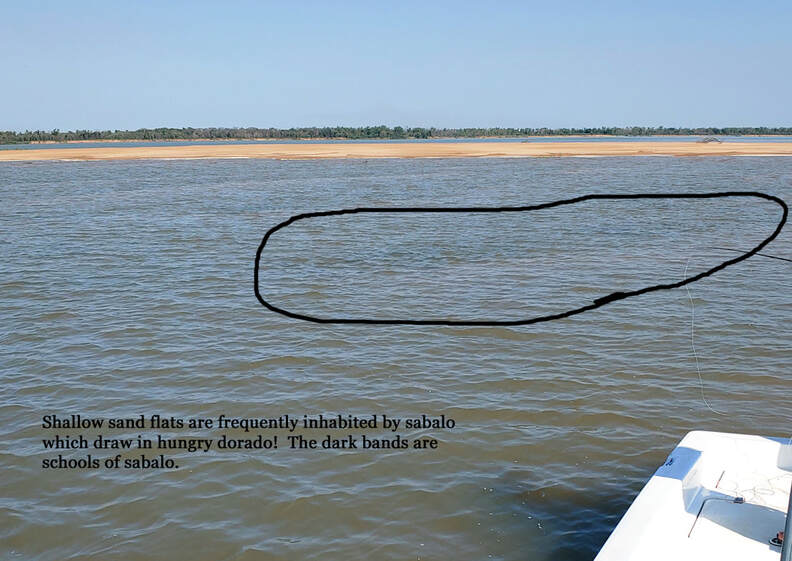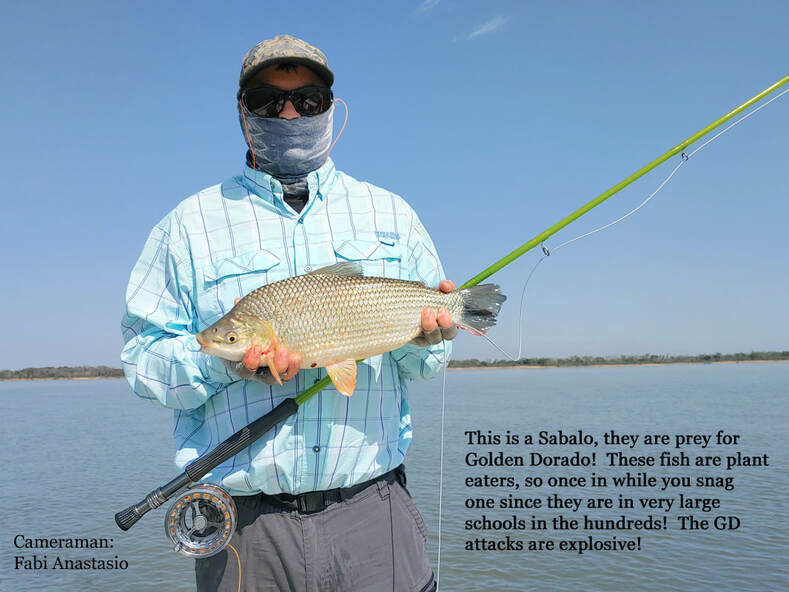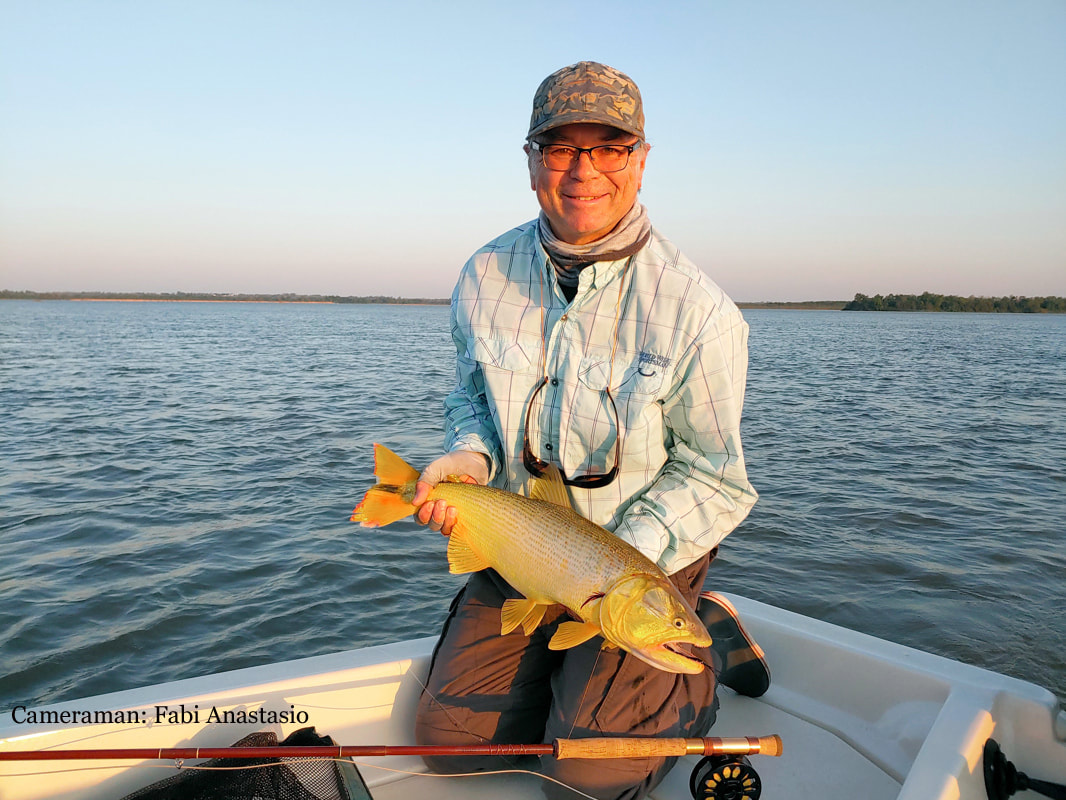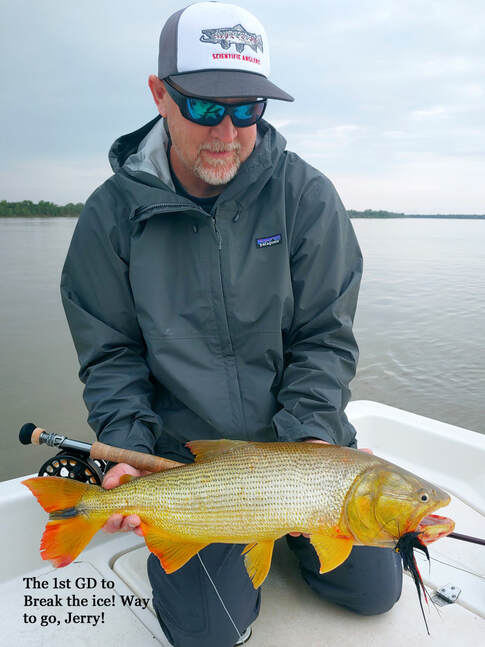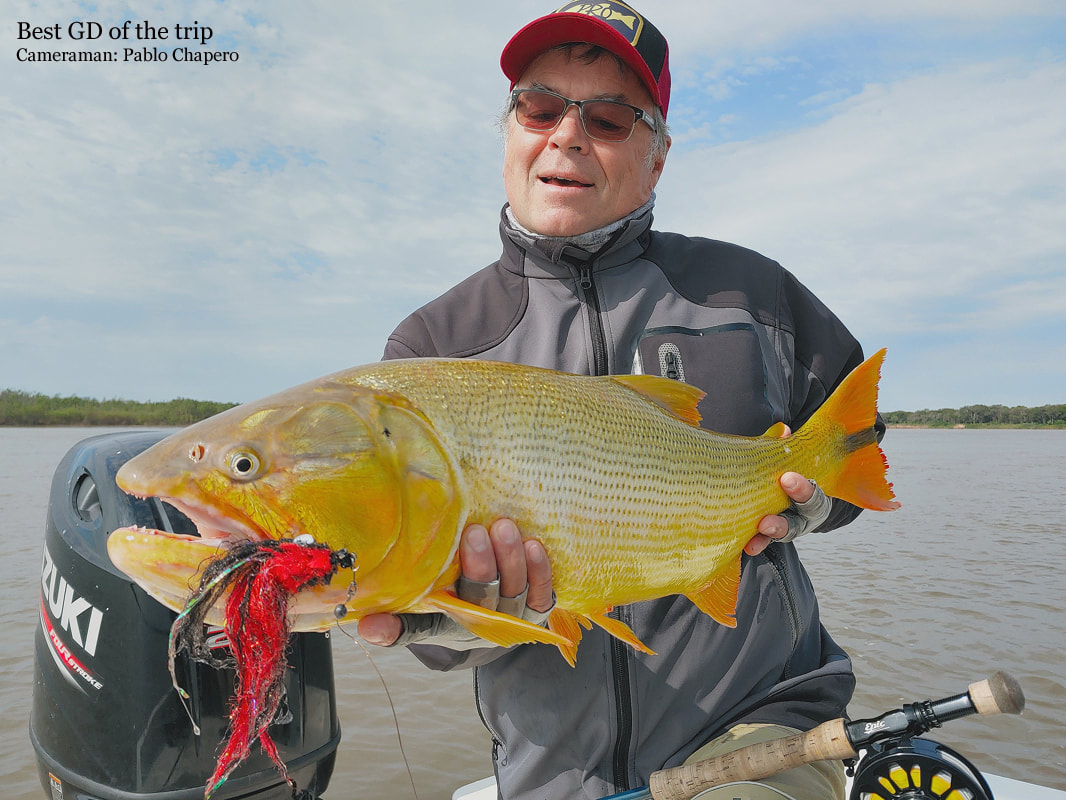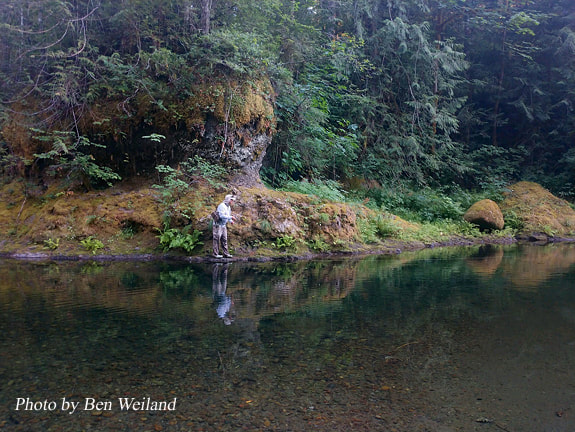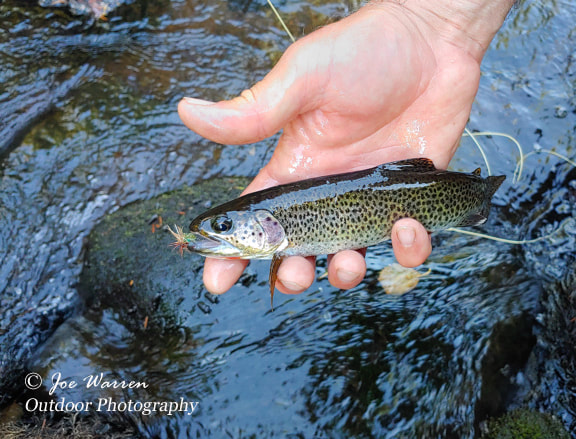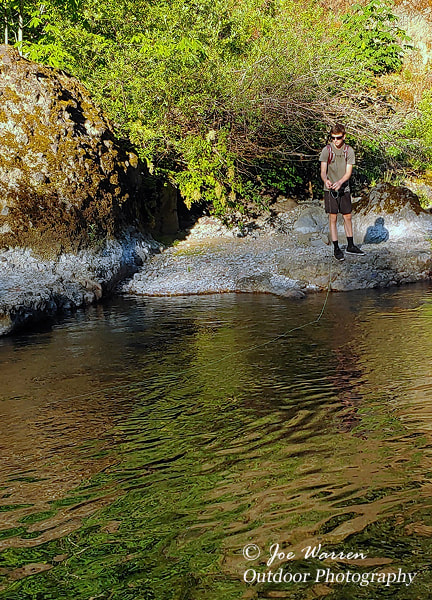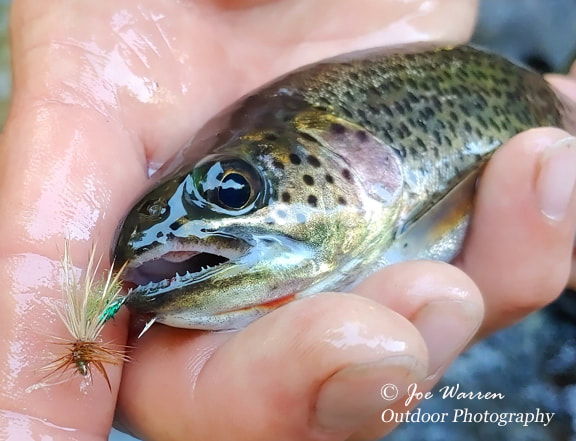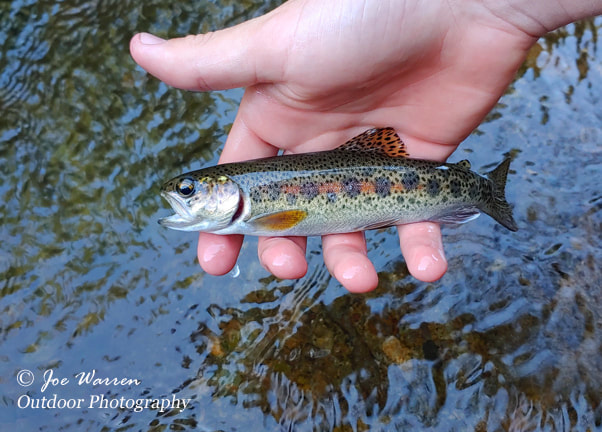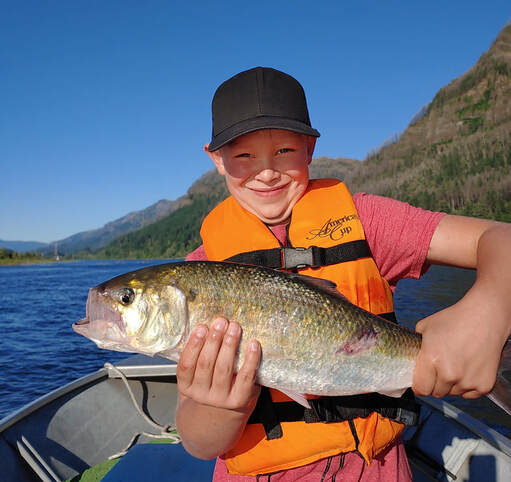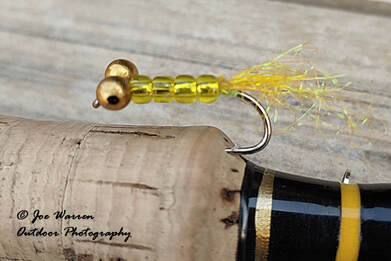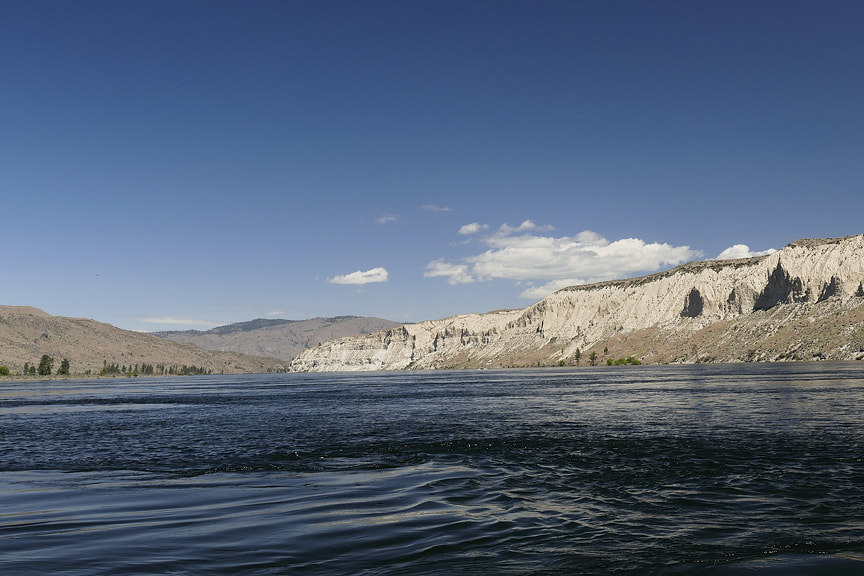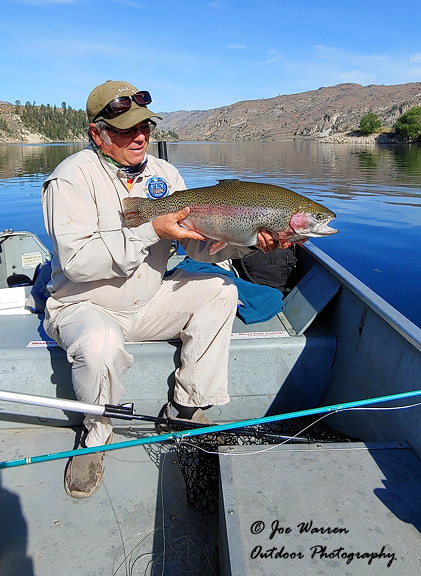Lake Billy Chinook & Fall River
Fall River 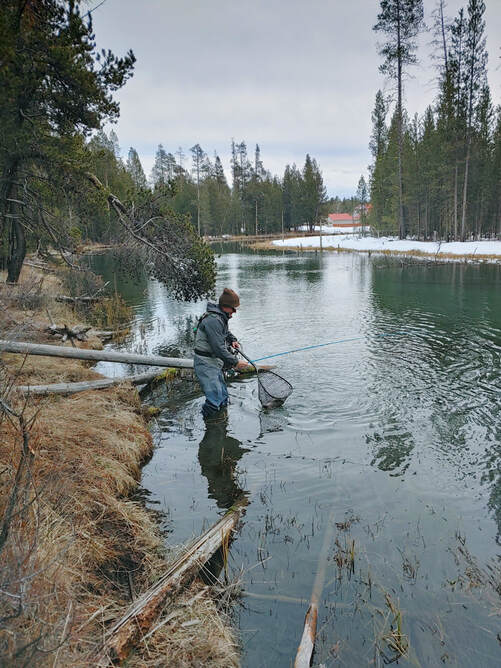 The next day, we changed up a bit to the frigid clear Fall River. I got break on this day and actually caught fish! As did BG too. BG had two glass fly rods already to go and I grabbed his 3 wt (absolute blast!). We used floating lines and caught most of the trout on smaller flies ranging from size 20 to 14. I don't claim to be much of a dry fly fisherman not to mention finesse fishing tiny flies but I actually hooked 3 nice bows on a #16 Parachute Adams during a BW hatch! That's a big feat for me. Per BG's suggestion, I also enjoyed taking a couple of nice brutes swinging a soft hackle, steelhead style. BG also picked off some bows too with small flies such as midge type patterns and a somewhat BW emerger (very tiny, like a size 20!). Perhaps the best treat of all was that we had the whole stretch to ourselves! I suspect both places can only improve as the weather and water temps start to raise. On the Fall River, I was quite surprised how strong the BW hatch came off along with an odd caddis now and again. The fish responded well as the bugs came out which made for some decent dry fly action.
I hope you are finding some good water to fish in between the wet and cold fronts moving through. As for me, the next fly fish pursuit is Pyramid Lake in two days and I hope the weather is more on the crappy side than nice! Stay tuned! Tight lines in your fly fish pursuits! Joe
0 Comments
Lake Billy Chinook 1/16/2023 With a break in the cold blustery weather, it was time to go see what was happening on Lake Billy Chinook. Fly fishing friend, BG Eilertson, joined me for my first fly fishing trip this year to go hunt for bull trout. Since the Metolious arm is closed, that leaves either the Crooked or Deschutes arms open to fish. We chose the Deschutes side. Not much happened below the bridge crossing, so we picked up and headed upstream to the narrows. It did not take long to find grabs. The upper reach has always produced browns in the winter, but mostly smaller ones in the 12-14 range. However, the bull trout venture in and out and at times you might catch a decent pack. We managed only a few as seen in the photo above. A couple of rainbows also came to the net as well. I suppose one could say that BG and I caught the LBC trout slam! Streamers worked very well on the small side like 2-2 1/2" long in olive and white, although my largest brown did grab a 4" streamer. We used about a 250 gr sinking head on intermediate running line casting with 7 weight rods. It was nice day to get out of the house, catch a few fish and think about the next trip to find the big bulls! Tight lines in your fly fishing pursuits!
Joe Designing Popper, Sliders & Divers Wow! First question I have for the author is, how long did it take to write this book? On the back cover it says, ". . .most comprehensive book ever written for the top water lure maker." That's an understatement, lol. Mr. Schweitzer did not miss ANY detail on this subject ! I just happen to come across this book in Amazon and when I saw it, I just had to get one to check it out. No disappointments at all! 305 pages, softcover spiral bound (very cool) and the photography is top notch! Eight sections of information from cork to foam, markers to paint, glues to resins, eyes, and tons more. There's even a page of the author's recommendation of "Best" products he prefers himself. He makes very good use of charts and diagrams, especially color charts for paints! There are 17 topwater patterns with complete step by step photos to duplicate. How about tying a "Harvey Wallbanger"? :) He also included a half dozen fly tyers with an "Artisan Galleries" showing their popular patterns from guys like Pat Cohen and Kirk Dietrich. For me, this book is a slice of heaven simply because it has helped me over come my frustrations with important details like painting, body patterns, adding eyes, final finishes, etc. I like to play with wine and lab corks and lathe them to different shapes. I know, this is very time consuming but it's fun to start from scratch! Also, this book is not about creating just a common everyday popper. There is a plethora of top water types, which, even includes tying with craft sheet foam with an example of a foam hopper! Folks, you're not even going to come close to finding all this information and technique on Youtube. I HIGHLY recommend this book! This fantastic work of penmanship and photography makes it the best fly tying book I have ever seen! Suggested retail, $44.95 (worth every penny) Available asap on Amazon Please note: I am not endorsed by any means by the author or a retailer for this review. I purchased the book and the review is strictly my opinion. Thanks for reading! These are just a few of some of my own creations. The book really opens up a fly tyer's creativity. I didn't realize there was so much one could do to create a top water fly!
Tight lines in your fly fish pursuit! Joe October 1-4, 2022 Photos by Joe unless otherwise noted Stillwater trout fly fishing can produce some of the largest trophy trout anywhere! Though fly presentations can vary substantially from the tiniest of chironomids to large, floppy, traveling sedges, my personal preference is “rope” size leader stripping a streamer! I’ll settle for one exceptional size trout for the day over double numbers of modest size trout. Two feet or longer is the size class I am after, anything less is a “dink”. Henrys Lake in eastern Idaho is no exception. This year I was privileged to receive an invite with a group of five other Washington fly anglers to the famous, Henrys Lake. It is my first time to visit and fly fish this beautiful place arranged during the first week of October. The yellow-orange colored aspen decorated the lake and the “pop” of shotguns sounded off to waterfowl harvest that expressed fall has started. The 12-hour drive the day before doesn’t seem to affect us as we leave at dawn for the lake. We arrive to the lake only to find it very turbid, apparent from the fall turnover phenomena. The group leader remarks he’s never seen the lake this way in previous years. Paul further remarks it was not the norm as clear water was expected. Previously, he explained to me the joys of clear conditions that afford the nearshore weed beds giving up spectacular fishing in the open pockets with opportunities to sight fish. However, we were at the challenge of fly fishing a cloudy lake! I was stunned by the large groves of weed beds too! I have to admit, I’m generally not a large group kind of angler, but the group coordinator’s efforts of bringing it all together was excellent and the company was nothing short of a blast! With three boats, anglers rotate boats each day to become acquainted bringing a new chapter to fly fishing experiences. Of course if your boat was into fish, you let the other boats know about it, and if you caught the most, half the fun was keeping score of the catch rate just to rub it in a little bit (aahhh, the virtue of cell phones). Cocktail hour and dinner recall the moments of the day; more ribbing, with smiles and laughter. After comparing notes, some tackle changes are made to hopefully up the catch for the next day. I’m reminded of good sports with a sense of humor who generously help each other with sharing patterns, fly lines, etc., to make a trip like this a wonderful memory! On this trip, the fly fishing was blind fishing at best with the use of sonar to find open pockets. Yes, it was that turbid! The fish were spread out and some quite a distance, sometimes hundreds of yards from shore! I was very surprised how shallow the lake is as we typically fished in 9-12 feet of water quite a ways from the shoreline. However, according to my cohorts, who fished Henrys before, the catching was nothing like previous years with numbers of +20 fish per day. On this trip, with two anglers per boat, 6 to 8 trout was a good day. Throw in gorgeous, chuncky cutts and hybrids and it took some of the sting away. All in all, you either found the fish, or went bite-less. Lots of casting and moving was the norm. When the fish were located, it was game on with the beautiful Yellowstone cutthroat trout or the “hybrids” (Yellowstone cutthroat cross with a rainbow trout). Also in the mixed catch were the occasional, nice size brook trout. We also caught decent numbers of cutthroats and hybrid trout over 20 inches! The lake is well known to produce large hybrids into double digit, pounds! On the day we last fished or very close thereof, a local female angler landed a new catch and release record hybrid that taped out at 36 inches long! Estimated weight was 17-20 pounds! Dang! It’s always my luck a giant trout like this is caught right when I am also fishing the same lake! None the less, a fish of this magnitude clearly illustrates the potential the lake has for rearing trophy trout! I’LL BE BAUK.
Pattern wise, there was not a single fly that consistently produced the most strikes. Between the six of us using a gamut of offerings, the only hint of a favorable fly was a bugger tied black n purple or black n blue. I was told the hot color last year was claret, but not this year. I even put some time in with an olive scud (as advised to me) and only managed 3 trout but one of the biggest came on that fly. Other flies caught fish too; midges, balanced leeches, boobie, Pyramid popcorn beetle (in black and purple) and one late evening we did very well with #10 white buggers! Heck, I even tried a 5 inch streamer and managed one small cutthroat. This time, catching is more of a matter in keeping your fly in the water than anything else! We also fish various types of sinking lines or a floater but a type III sinking line seemed the best fit using a fairly fast, short strip retrieve to provoke a strike because it sure didn’t seem they were all that hungry!
Tight lines in your fly fishing pursuits,
Joe Fly Fishing Outlet: Drift Fly Shop, Island Park, Idaho, (208) 558-0152 Reference: https://www.einnews.com/pr_news/588718768/henrys-lake-quarterly-newsletter-summer-2022 August, 2022 Photos taken by Joe unless otherwise noted. Whatever you’ve heard, read or seen on You-Tube, about golden dorado, is true. They are one of the most viscous and aggressive freshwater predators and they are just as golden alive as they are in pages of magazines! A large head packs powerful jaws with saw-blade sharp teeth! The thick body and broad tail enable this apex predator to jump clear of the water like a tarpon, multiple times, and pull like a bulldog. Here is my adventure chasing my golden dream. It was a loooong wait to finally have my shot at for Golden Dorado in Argentina. COVID did to me like it did to everyone else and having booked the trip for 2020, it was postponed until 2022! The trip was conducted through Parana River Outfitters (PRO) owned and operated by Fabio Anastasia and Pablo Chapero. They are also the main guides who are local natives and well-seasoned for golden dorado! Booking arrangements were taking care of by Nervous Waters (who have many classic fly fishing destinations). As my partner, Jerry and I flew in to Buenos Aires early in the morning, I caught a good view of the Parana River and was amazed by its size. That's when it got real, and the jitters kick in with the reality of golden dorado just up the river. But wait! There’s still about 7 more hours before we reach the final destination on the middle part of the Parana. My jitters are going to have to manage without me, we jump on another plane and fly to Corrientes and then another 45-minute car ride south to Bella Vista to our final destination. The traveling is exhausting but the promise of golden dorado the next morning was tantalizingly close to being a reality that I had waited an eternity for. The first impression of the river is its vastness. You feel small against this huge body of flat water. The Parana at this location is impressive. Looking at the river on our first morning I wondered how do the guides ever find the dorado?
Another fish-able option are the huge shallow sand flats, where hundreds if not thousands of sabalo can be schooling up. The sabalo, an herbivore, are very large for a baitfish (like 3 lbs) which is likely one of the reasons why dorado can surpass 30 lbs! Hence using big flies. The stalk on the flats is very, very, slow in terms of wading the area. You don’t actually see the dorado, only the reaction of the school of sabalo which is either an open hole in the middle of the school or a frantic white water spray on the surface as they try to escape from the golden wolf! If this happens within casting range, that's your shot to make the cast and hope you get bit! Fishing conditions were tough while we were there for 8 days. Lots of difficult weather changes and a rapidly rising river challenged being able to find fish. Although, river turbidity doesn’t seem to matter too much as these predators have keen vision to pick off their prey! A large snaky black streamer with weighted eyes about 6-7 inches long drew attention if the golden dorado was present. We didn’t catch a bunch of dorado but the few that were caught sent my adrenaline wide open! I can’t wait to go back, somewhere out there is a 20-30 pound dorado with my name on it! If you are an avid traveler in fly fishing, you always try to book your trip by the o’l adage, “timing is everything”. But, it’s always a crap shoot because you never can control the weather. However, I can attest that the overall experience was great! There were no disappointments when it came to the culture, the scenery, wildlife, and company of the guides, hosts and chef and eating great food! The shoreline lunches rock! I always joke about taking trips just to eat the food and PRO did not let me down! Perhaps this trip was only a small fortune in gold but I left the big river very educated and humbled (trout sets suck!). A return trip is definitely warranted and I will be twice as ready to catch the trophy golden dorado! Tight lines in your fly fishing pursuits!
Joe For more information, you can contact myself, or go to the web sites, Parana River Outfitters, or Nervous Waters. Gear: Fly rods- Epic 8’8”, 8 wt; custom NorthFork LMX 8’ 6”, 8wt; Fenwick FF 112-5, 9’ 3”, 9 wt Reel - Aspen 400M Lines - Rio Coldwater Winter Redfish WF9 & 10F, AirFlo Depth finder 300 gr (highly recommended is a floating line mult-tip with 10’ changeable tips of various sinking densities) Leader – four to five feet 50-60 lb mono butt section connected to 20-24”, 40 lb multi-strand wire. September-December, 2021 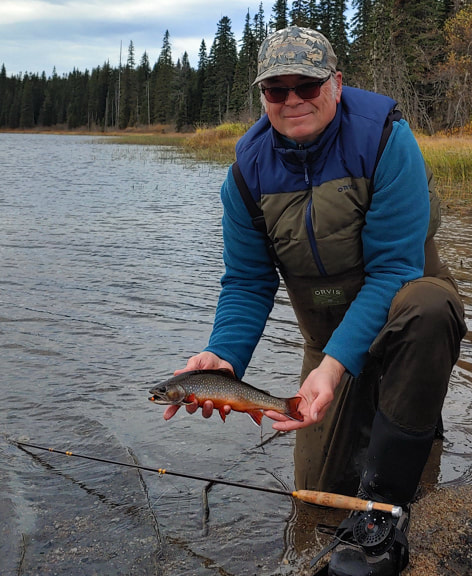 Colorful brook trout on a black beadhead bugger. Colorful brook trout on a black beadhead bugger. I launch my Water Master into the tea stained water and head for my favorite spot on the lake. No one is around, it's mid November and the temperatures have dropped substantially; a slight breeze sends a chill across my face. Only minutes later my line stops and I'm hooked up! It's a very plump brookie, about 14 inches long with the vibrancy of brilliant spots and flame orange belly! They are aggressive and are on the prowl to stuff themselves before this particular lake freezes over. My Hardy Jet 4 wt fiberglass fly rod is just the right rod for these medium size trout. When it bends to the handle, it gets exciting! My first fly caught trout was a brookie and I never get tired of them. A beautiful fish that is super aggressive yet wily enough to refuse your presentation! Two other cousins of the brook trout that are not far off for me to pursue, are the bull trout and lake trout (aka mackinaw). The greatest advantage of late fall fly fishing is that many anglers also hunt or maybe they're fair weather fisherman. Whatever the case may be, the opportunity leaves plenty of room to fish on the lakes. Bull and lake trout are apex predators where they thrive. So guess what kind of flies work? My favorite of course, BIG streamer flies! Four to six inches long, I'd say that's big, served on a size 1 to 3/0 hook! I like to use integrated sink lines, 300-400 gr to get em down deep. My line pick is the Airflo Depth Finder with intermediate sink running line. I commonly use an 8 wt glass fly rod for both species. Where you find one bull trout, there are typically more. They can school up pretty close to shore, which is why you want to drop you fly fairly close to the shore depending on the depth to begin the retrieve. Bull trout are found in rivers or lakes. Personally, I think the lake form, lucustrine, are much more robust and fight harder. They tend to eat a lot of kokanee. An 8 wt rod is best and I wouldn't hesitate to use a 9. Stout gear is in order plus I'll use 15 lb fluorocarbon leader. They don't call em "bull" trout for nothing! Lake trout are very different from bull trout. To catch one with a fly, window of opportunity is much shorter, which, occurs when lakers move into the shallows in late fall (pre-spawn) and will hang near shallows till ice out. Problem is, most lakes with macks become snowed in and that ends the game. Lakers can also be more solitary and it's a good idea to move around and try different areas. Since they spawn over rocky bottoms, it's a good approach to fish over this type of structure. It's not uncommon to hook lakers well into the double digits. Like the bull trout they pull and bull dog and can turn on a dime quick enough to break your line or rod if you're don't lighten up! Both of these char species are primarily fish eaters. Streamers that resemble rainbow trout, kokanee and/or whitefish are good bets. But colors like white, yellow, black or purple should not be discounted. Fairly fast retrieves seem to work best even when the water is 45 degrees. Oh ya, I have found that early am can be the best time for lakers especially for the big boys. Unfortunately, it is often well below freezing, however, in the wee hours of light when you hook a 37" big mack, it helps warm the o'l bod up in a big hurry! The late fall season can be a great time for targeting trophy char species. A trout of a lifetime could be prowling near shore at any moment, so don't let the cold or inclimate weather stop you!
Tight lines in your fly fishing pursuits! Joe July-September, 2021 Better late than never as they say even though it is now December as I write and post this latest blog. Hopefully someone will appreciate it . . . When you live in a place like the Columbia River Gorge, there are many quiet places off the beaten path to catch a few trout. Dry fly fishing in small streams or stillwater fly fishing in one of many lakes in Skamania County is not only convenient but a peaceful opportunity to catch trout on light fly rods. In my case, the weapon of choice is a 2-4 wt fiberglass fly rod. From the creeks and streams, the trout are not lunkers by any standards, but they are wild, native and beautiful specimens none the less. They are super aggressive to take a #14 elk wing caddis too! Both sides of the Columbia River offer numerous tributaries with wild trout. I believe it is safe to say that if there's water year round, there is trout living there! The other option are the many lakes that can inhabit rainbows, cutthroat, brook, brown and tiger trout, wow! The majority of the lakes are stocked though some have brook trout that self populate. To fly fish these stillwaters, I highly recommend at least a float tube, especially in the brushy shoreline, high lakes. Small stillwater patterns like buggers (black or olive), damsel nymph, dragonfly nymph, pheasant tail nymph, copper john nymph, hare's ear nymph, renegade, etc, work well. Size 16-12 on standard nymph patterns, 8-10 for buggers. With a floating fly line you can fish balanced leeches too. A two fly presentation with a midge and a balance leech under it can be killer. The trout are generally not too picky. If' it's slow, change up till you increase takes and also don't forget to change retrieves too. If you like to hike and camp, the high lakes in the Gifford Pinchot offer productive fly fishing. Just make sure you bring plenty of mosquito repellent! Trout fly fishing in these areas is about the solidarity you have and the outdoor beauty surrounding you. And if you're fortunate, the trout are biting to give you a bonus!
Tight lines in your fly fishing pursuits! Joe July 2021 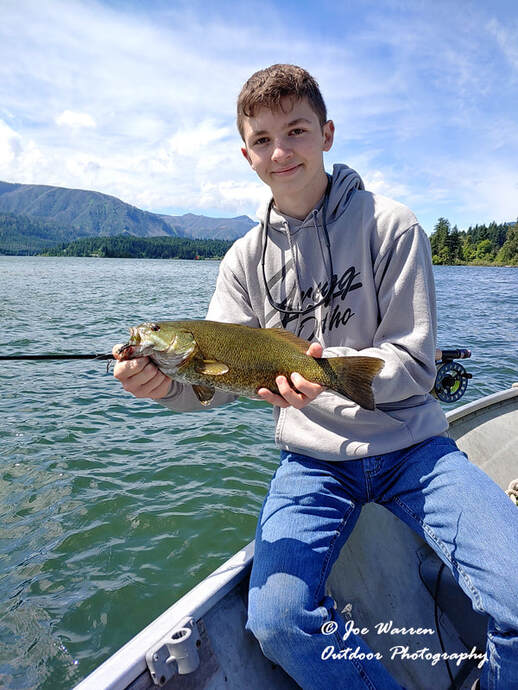 Youth fly fisher ready to release a nice smallmouth bass in the Bonneville Reservoir, WA. Youth fly fisher ready to release a nice smallmouth bass in the Bonneville Reservoir, WA. The smallmouth continue to feed near shore and are still within reach for fly rodders. Fast sinking lines work well over drop offs along rip rap or rocky points. Don't hesitate to cast a popper along weed beds either. Small juvenile shad will begin there out-migration very soon and the bass will be going bonkers on them. From August through September, I highly recommend the John Day pool as larger bass will be near shore. Don't want to compete with weekend warriors? Go after smallmouth! Only have a couple hours after work? Go after smallmouth! Very aggressive, very plentiful, and not too hard to find! Tight lines in your fly fishing pursuits! Joe June, 2021 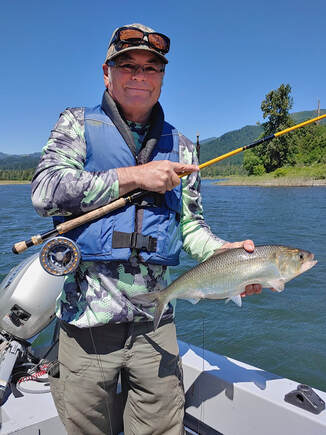 Shad fly fishing on the Columbia River below Bonneville Dam. Shad fly fishing on the Columbia River below Bonneville Dam. I really enjoy using my fiberglass fly rods for these fish and they are very forgiving to not pull the hook. Fast sinking lines are highly recommended, such as Cortland's Compact or the AirFlo Depth Finder, which have integrated sinking heads with an intermediate sink running line. Depending on flows, 300-400+ gr lines are necessary to get to down to the shad! I use a 4 to 5-foot leader with 15 lb. tippet. Shad fly patterns are a dime a dozen and the best ones are very bright whether it's hot yellow, fluorescent green, or red and even gold is good. If the pattern has more than 3 types of materials, forget it! Chain bead eyes, a body material and tail on a 2x stout hook and you're in business. My go to pattern is my Sunshine Shad fly consisting of 4, hot yellow silver lined glass beads, a chartreuse tail of some sort and large silver or gold chain bead eyes. Pretty easy to fly fish for shad. You can either strip you line out behind the boat about 20-30 feet after the darker shooting head and let it idle in the current just off the bottom, or you can jig the fly pulling the line back and forth to provoke strikes. You can also cast towards the shoreline and hook em on the swing! This is my favorite way to catch shad on a fly, kind of like that grab from a steelhead! Fly fishing for shad in the summer evening on the Columbia River is an awsome time that is usually fish after fish on the line! Beautiful scenery in the Columbia River Gorge is icing on the cake as you fish till the sun drops behind Beacon Rock. If you have any questions, feel free to reach out to me on my contact page. Tight Lines on your fly fishing pursuits! Joe May 26-31, 2021 If I only had one place to fly fish in the Pacific NW, it would be Rufus Woods Reservoir on the Columbia River. This 54 mile long reservoir between Chief Joseph and Grand Coulee dams is incredible streamer and stillwater fly fishing, although the upper 1/4th of the reservoir is my preferred location. It is bordered to the north with the Colville Confederated Tribal Reservation and to the south by WA state. I was just there for a long holiday weekend and given the size of this reservoir, I had no competition to my usual accustomed places to fish! The trout fishing was excellent to say the least with most daily catches above 50! Yes, that’s right, 50! There is a lot going on here in the way of trout. The very large triploid rainbows have put this place on the map with the state record at almost 30 pounds! However, there are many different forms of rainbows in this river/reservoir. There are wild trout but unfortunately, not very many and hopefully the tribal and state agencies will protect them to all “release”, as the hatchery fish are all clipped. Roosevelt Reservoir above Grand Coulee Dam also contributes hatchery rainbow trout of the normal type, ie, not triploid. There are also large kokanee, browns and whitefish and on rare occasions, brook trout. Smallmouth bass and walleye are also there and take flies. 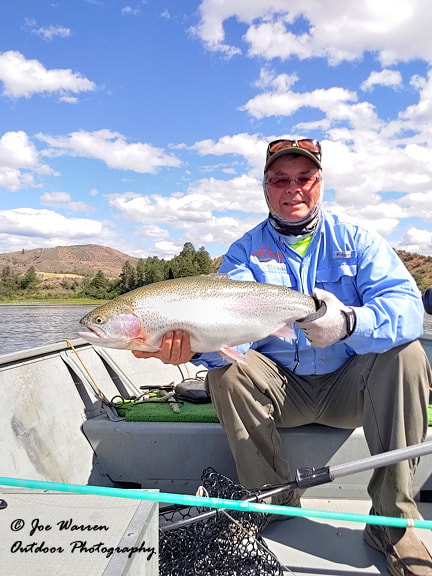 Author with a 8 lb triploid rainbow trout on Rufus Woods Reservoir. Author with a 8 lb triploid rainbow trout on Rufus Woods Reservoir. Rufus Woods is a river and lake all in one depending on what the dams on doing with the water. If no water is moving, you have a lake environment. When the dams are passing water, it’s obviously a river. You have to know how to you change up your game when things change with dam operations. A nice calm day when the river is slow makes for excellent streamer fishing while you drift along the banks and cast a fast sinking line (250-300 gr) with a something like a big #2 black bugger. The takes are incredible and so is the fight. Then you have areas that are off the main channel that are essentially stillwater zones. Here, the game is with a floating or camo intermediate sinking line casting small buggers in sizes 10-8. Midges are prolific on the Columbia and certainly you can entertain that type of fly fishing if you’re into that. I often see bobber fly fisherman doing very well at Nespelem Bay. I like to fish between Seaton Grove boat launch and Tim Brothers farm downstream. A motor boat is the best way to fish Rufus Woods. However, one of the best places for stillwater fly fishing is Nespelem Bay and with the proper permits you can even launch float tubes or pontoons from the shore. 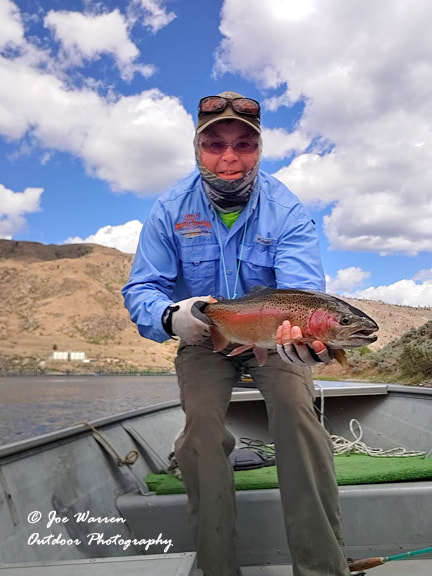 24" wild rainbow trout, a special treat as they are not common! 24" wild rainbow trout, a special treat as they are not common! My preferred time to fly fish is February-June. I have only fished the fall once in mid-November and it was slower than usual but I did catch a gorgeous, 28” hatchery rainbow that looked just like a steelhead in spawning colors to boot! The cost of fishing or recreating on the Colville reservation has changed immensely. I’ve been fly fishing the reservation since 1992 and now the cost to play on the reservation for non-tribal members has gone up! For starters, I was told by the Parks and Recreation department that there is a $80 fee that is required BEFORE you can even purchase a fishing, camping, or whatever kind of permit! They have now included a boat launch permit as well, $10/day, or $80/year. If you have a motor boat, you can avoid the tribal fees by staying overnight off the reservation and launching at the Seaton Grove site. This site is owned by the Corp and is not under jurisdiction of the Colville Tribe. A WA fishing license is only required. Just make sure you don’t step foot on the reservation. This is a wonderful place to explore and has fantastic rainbow trout fly fishing! Furthermore, if you do decide to fish on the reservation, there are many, excellent lakes including another one of my favorites, Omak Lake that has Lahontan Cutthroat trout!
Tight Lines on your fly fishing pursuits, Joe |
